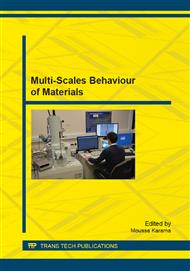p.39
p.51
p.64
p.74
p.83
p.96
p.112
p.124
p.130
Optimizing Residual Stress Profile Induced by Laser Shock Peening Using DOE Technique
Abstract:
The control of residual stress is crucial in ensuring the integrity of engineering components and Laser Shock Peening (LSP) process can be used to good effect to introduce the beneficial compressive residual stress levels required. It is, however, difficult to use normal laser peening control systems to establish the ideal peening conditions that will result in the best component performance. This paper presents results from a study to optimise the laser peening parameters for a typical titanium super alloy used in high performance turbine blade by investigating how the main peening process parameters influence residual stress profiles resulted by numerical simulations. Statistical Design of Experiments (DoE) was used to limit the number of experiments required for optimisation to be possible. Using this technique and numerical depth profiling methods for residual stress analysis, the maximum compressive residual stresses in Ti-6Al-4V were measured for a range of peening conditions. The results of the detailed process characterisation investigations have shown that, by using careful DoE, it is possible to fully optimise the laser shock peening process to obtain greater benefits than would be possible with traditional control processes.
Info:
Periodical:
Pages:
83-95
Citation:
Online since:
December 2011
Authors:
Price:
Сopyright:
© 2012 Trans Tech Publications Ltd. All Rights Reserved
Share:
Citation:


